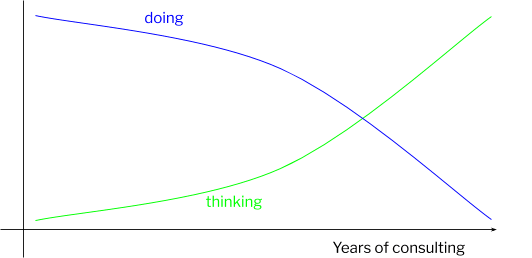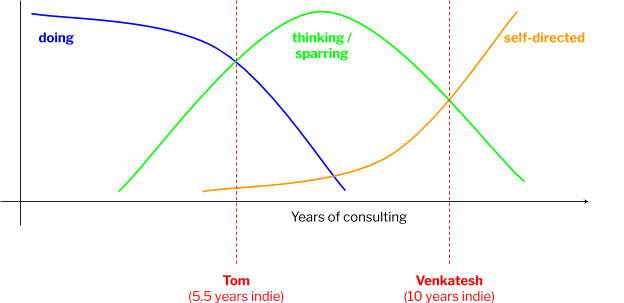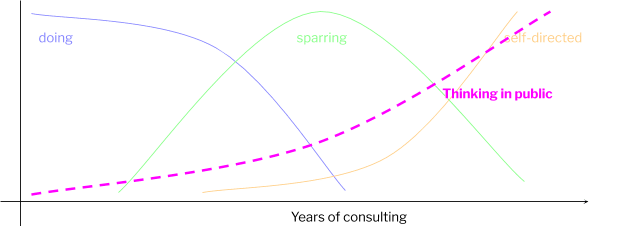Sparring & Tenure for Indie Consultants
A guest post on Art of Gig
There’s very little writing and knowledge available for indie consultants that is any good. So I’ve long admired Art of Gig from Venkatesh as a breath of fresh air and thinking. It’s helped me a ton in my own journey as an independent. So it was a great honor to get to write a guest issue for the newsletter. See the original here. Thanks Venkatesh. I’ve published a copy here for my archives:
I’ve long aspired to be an indie consultant with a default mode of sparring work. From reading about it on Venkatesh’s website to experiencing it in brief flashes on consulting projects (often waking up on the mat, dizzy, wondering what hit me), sparring has been an aspirational end goal; something to quest towards.
I’ve been an indie consultant for ~6 years and have gradually managed to secure sparring consulting engagements. But rather than operate on stand-alone sparring engagements they’ve been embedded (often at the end of) a “more traditional” consulting engagement focused on deliverables and such.
However, I recently participated in the first sparring training dojo as part of the Yak Collective and came to the realization that pure consulting sparring is an odd thing to quest for. For starters, it’s not very lucrative, as Venkatesh outlines:
I estimate that a good sparring partner can support no more than half a dozen active clients in any given month without burning out. And it typically takes half a dozen meetings of 60-90 minutes across six months or so for the sessions to become truly high-value.
Most importantly, though you might be able to bill at a high rate, due to the individualized, automation-resistant, time-intensive nature of it, you’re not going to get mega-rich doing it. Sparring is an artisanal kind of consulting. You can make a decent living from it, but if you’re solving for big money from a 4-hour work week, you should look to a different kind of consulting business model.
Contrast this to a more traditional consulting gig that might be 5 figures a month and involve several days of work a week.
So how can it be that sparring is such an aspirational model for indie consultants?
Thinking vs Doing
I believe the answer lies in the aspirational nature of sparring work — in short, it’s thinking for a living.
Maybe the best analogy is: reaching a point as an indie consultant where you can generate enough clients to be sparring as your sole consulting work is like reaching tenure. You’re set.
Let’s illustrate with a dumb graphic:

My theory goes:
When you start out consulting most of your billable hours are spent doing. You get hired for things like writing content, managing ad campaigns, photo shoots, executing campaigns, building websites.
As you get more senior, more experience and as you get access to more senior executives the work starts to include thinking. Your website design project is so good that you’re included in the brand refresh project, your marketing campaign was so good you are invited to restructure the marketing org, your project management was so good you’re invited to help shape OKRs for the company, etc.
Thinking for a living is more fun.
Thinking - the work where you’re looking at client’s organizations as complex systems with access to real decision makers is where the rewarding high value work comes in.
As you get a taste of thinking for a living it becomes tempting to want to spend all your time thinking.
The (wrong!) mental model here is of the indie consultant rising to partner status — a partner at McKinsey or Bain spends all day long thinking, not doing. So we chase the same as an indie consultant — aspiring to get paid handsome sums of money to think all day long.
Except. As an indie typically there’s no one to delegate to. So you need to roll up your sleeves and blend doing and thinking. (I’ve written about this concept under the label “strategy and stewardship” in this post the strategic independent).
This is where I find myself 6 years into my indie consulting career. Blending executive sparring with executive level capacity building for clients. This might look like:
-
A weekly sparring session with the CMO, and:
-
2-3 days a week working with the marketing org on various strategic initiatives
The first feels like getting paid to think, the second feels like getting paid to do.
My hunch however is that this is a local revenue maximum. I often work with clients where I get paid approximately a sparring day rate across all my work — both the thinking and the doing — and this lets me bill well and log a good number of hours per client.
While I’d love to abandon the doing work and focus on the thinking — on the sparring — I think it’s a mistake to prematurely optimize for thinking for a living. Especially while I am young enough to have some doing left in me.
But — 6 years into my indie consulting career — I’m laying the foundation for transitioning to sparring in the next few years. Sounds crazy? There are some good reasons.
The Benefits of Sparring: Owning your Time
So is sparring just an intellectually stimulating but less-well-paid version of consulting?
No — there are some clear benefits of chasing sparring as consulting.
Firstly, I’m a decade younger than Venkatesh and still able to pull stunts like billing 3 days a week to one client and 3 days a week to another client. Dipping into energy reserves and sprinting on work for sustained periods throughout the year. Much like physical fitness I can already feel my capacity for this declining.
Secondly, doing captures a large portion of your head space. When you’re managing a marketing org you can’t “take Thursday and Friday offline to write blog posts”. Operational work requires high availability and an “always-on” mentality. Especially if you’re in doing mode for multiple clients at once. It can be incredibly demanding on your time and any side project / writing / teaching / long-term research gets consistently interrupted, paused or put on hold.
Thirdly, doing is not resilient work. Doing work is much more reliant on the economy, access to local clients and more. Conversely, sparring work thrives in uncertainty as Nicolas Colin wrote in Launching My Executive Sparring Practice:
What do you do as an executive in a world perpetually ridden with uncertainty—because of the nature of computing and networks, because of macroeconomic ups and downs, because of the public constantly threatening to erupt in revolt, because of activists that are all too happy to fuel that perpetual fire to force you to comply with whatever they demand?
What you do is find a good sparring partner who will help you navigate the uncertainty with clear strategic insights and frequent adjustments to your worldview, helping you to constantly refine your long-term thesis.
Shifting to remote consulting has been a big strain on my consulting practice — not so much on Venkatesh’s.
In a nutshell, sparring work is long-term stable, well-paid work relative to the amount of headspace and energy required.
Tenure-track not Partner-track
Which brings me to the (correct) mental model — not of an indie consultant reaching “partner” but of indie consultant reaching “tenure”. The ability to consistently generate sparring clients is a great way to earn steady money, thinking for a living and with a reinforced OODA loop that connects the value you create for clients to the value you generate personally from sparring. As Venkatesh outlined:
You and the client are each driving complementary OODA loops that intersect in the practice of sparring. You are inside each other’s OODA loops in a way that mutually reinforces both your learning processes. Yours is an appreciative learning process, theirs is an instrumental learning process.
The ability to earn good stable money while keeping a significant amount of time and headspace free is not to be under-estimated. It maps to the idea of a tenured professor in the way that they are free to explore self-directed initiatives and projects.
Let’s update that doing/thinking chart form above to include a third wave of “self-directed” work:

As the doing work gives way to sparring work, so too does sparring work give way to self directed work. I’ve plotted myself and Venkatesh (roughly) on the chart to illustrate roughly where we both land.
Venkatesh, obviously, has been busy: Ribbonfarm, ArtofGig, Breaking Smart, Refactor Camp, Tempo, being a Berggruen Fellow, book #2 etc and is now earning a not insignificant income from self-directed projects.
And this is the end goal — the aspirational nature of yearning for sparring work — it’s that it’s a path, an enablement to get to a place where you can have some model of “tenure” to explore your own self-directed projects without having to force those projects to live on their own immediately. You leverage skill in doing into sparring work and you leverage skill in sparring work to get to self-directed projects and revenue.
Personally, I’ve updated my mental model. I’m no longer chasing sparring as it’s own goal but rather chasing sparring as a means to create leverage to maximize time, energy, and self-directed interests.
The Compound Interest of Networked Writing
The final point I’ll make here is about how to chase sparring. For indie consultants who want to follow this path (and to be clear there are other paths to follow) the evolution and progression across this chart from doing -thinking -self-directed is defined by the volume and quality of the thinking in public.
As Venkatesh illustrated in the guru factor:
About 90% of your effectiveness as a sparring partner derives from the depth of your appreciative world view, developed and expressed through critical reading, writing, podcasts, and talks. Only about 10% depends on your in-session sparring skills.
So we might overlay on the graph above a model of thinking in public (writing or podcasting or public speaking or vlogging):

Thinking in public is both a product of spending time sparring with clients and a necessary driver of getting sparring clients. In short, chasing sparring as a consulting model (and ultimately chasing the self-directed “tenure” model) requires investing in thinking in public, creating a self-reinforcing feedback loop of clients hiring you for thinking and higher quality thinking in public.
Working With Founders Who Have Conviction and Taste
April 16, 2024
March 20, 2024
This post was written by Tom Critchlow - blogger and independent consultant. Subscribe to join my occassional newsletter: